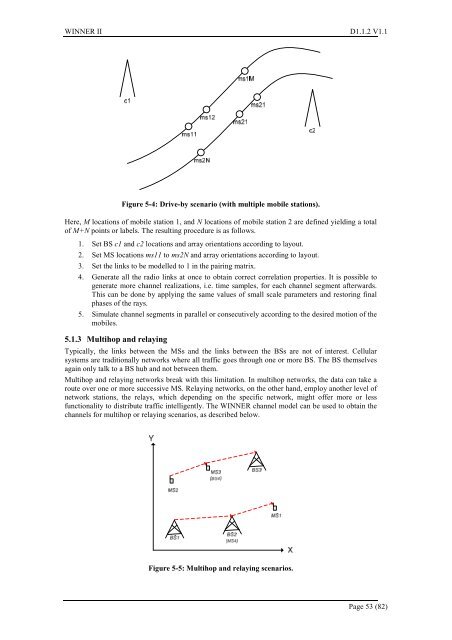"WINNER II Channel Models", ver 1.1, Sept
"WINNER II Channel Models", ver 1.1, Sept
"WINNER II Channel Models", ver 1.1, Sept
You also want an ePaper? Increase the reach of your titles
YUMPU automatically turns print PDFs into web optimized ePapers that Google loves.
<strong>WINNER</strong> <strong>II</strong> D<strong>1.1</strong>.2 V<strong>1.1</strong><br />
Figure 5-4: Drive-by scenario (with multiple mobile stations).<br />
Here, M locations of mobile station 1, and N locations of mobile station 2 are defined yielding a total<br />
of M+N points or labels. The resulting procedure is as follows.<br />
1. Set BS c1 and c2 locations and array orientations according to layout.<br />
2. Set MS locations ms11 to ms2N and array orientations according to layout.<br />
3. Set the links to be modelled to 1 in the pairing matrix.<br />
4. Generate all the radio links at once to obtain correct correlation properties. It is possible to<br />
generate more channel realizations, i.e. time samples, for each channel segment afterwards.<br />
This can be done by applying the same values of small scale parameters and restoring final<br />
phases of the rays.<br />
5. Simulate channel segments in parallel or consecutively according to the desired motion of the<br />
mobiles.<br />
5.1.3 Multihop and relaying<br />
Typically, the links between the MSs and the links between the BSs are not of interest. Cellular<br />
systems are traditionally networks where all traffic goes through one or more BS. The BS themselves<br />
again only talk to a BS hub and not between them.<br />
Multihop and relaying networks break with this limitation. In multihop networks, the data can take a<br />
route o<strong>ver</strong> one or more successive MS. Relaying networks, on the other hand, employ another level of<br />
network stations, the relays, which depending on the specific network, might offer more or less<br />
functionality to distribute traffic intelligently. The <strong>WINNER</strong> channel model can be used to obtain the<br />
channels for multihop or relaying scenarios, as described below.<br />
Figure 5-5: Multihop and relaying scenarios.<br />
Page 53 (82)
















